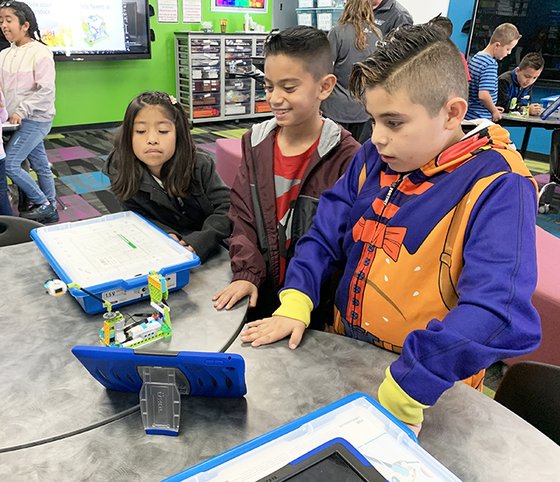Students ‘bloom’ in STEAM labs
March 16, 2020
For the most part, bee pollination is an outdoor activity. However, third grade students at Triple Crown Elementary School in Perris have brought the science of pollination into the classroom and recreated in it their STEAM lab.
“Last week we learned about how bees pollinate flowers,” said Triple Crown student William Preddy. “This week we came to the STEAM lab to create pollination out of LEGOs.”
The task seems simple enough. Build a bee and a flower out of LEGOs. However, William and his classmates went beyond the two LEGO models. They were using LEGO WeDo, which provides building materials, motors, motion and tilt sensors, as well as desktop or tablet software that teachers and students can use to learn about engineering and life, physical, earth and space sciences.
“It brings learning to life,” said third grade teacher Megan Schuck. “It’s hands-on and interactive and the level of engagement for these students is beyond that of a textbook or me talking in front of the classroom.”
STEAM labs such as the one at Triple Crown don’t just reside in a handful of schools. Val Verde USD superintendent Michael McCormick wanted every student, no matter what school they attended, to have access to these types of academic environments and collaborative spaces.
“The level of engagement for these students is beyond that of a textbook or me talking in front of the classroom.”—Megan Schuck, third grade teacher
“I wanted one of these labs in every school and my only requirement was video monitors and each one had to have a LEGO wall,” he said. “It’s about student opportunity and creating an environment that is engaging and fun.”
Which gets us back to the LEGOs and the bee pollination. Preddy and his class partners designed their structure on a tablet device and then went about building the elements. After design, coding and construction, they produced a bee that circled the flower as if it was in the process of pollination.
“There are 49 steps to build the model and once it’s built, they can use the programming to add music,” Schuck said. “They are on their own with these WeDo kits and you can feel the enthusiasm and excitement in the room.”
Deni Seagrave, who has been principal at Triple Crown for six years and attended the school as a student, says you can feel the excitement the moment you walk into the STEAM lab.
“We’ve had traditional computer labs and while there was excitement in them, there wasn’t the opportunity that allows students to explore and create,” she said. “The flexibility of programs like these are incredible and you see that the students are exchanging ideas and problem solving in new ways.”
Preddy says he and his classmates look forward to their time in the STEAM lab. It’s a new environment for them, one he said fills him with joy and excitement.
“I’m always really proud when I finish a project,” he said. “But the second I’m done with that project, I’m ready to move on to the next one.”

Students at Triple Crown Elementary School watch their LEGO “bee” rotate to simulate the process of pollination. All schools in the Val Verde Unified School District have STEAM labs where students can create and collaborate on projects like this one.
Third grade students at Triple Crown Elementary School in Val Verde USD use coding and LEGOs to build moving models of bee pollination. This activity is part of the districtwide STEAM program.


